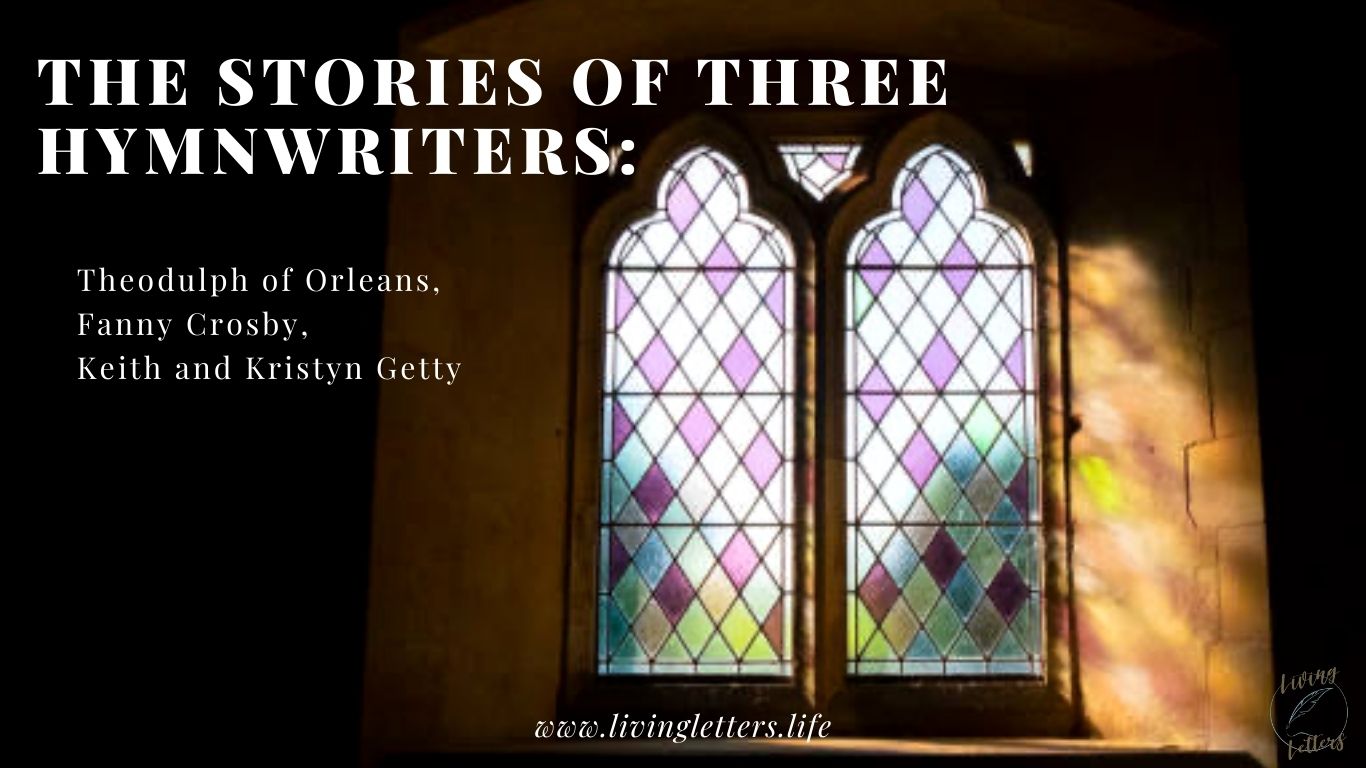
I recall once hearing an interesting anecdote about the infamous and loudly vocal atheist from the 1960's, Madaline Murray O'Hair. Despite her insistence that there was no God, whenever she was troubled about something, she reportedly liked to slip into the back pews of churches where a choir or an organist might be rehearsing or perhaps even in concert. She found that the sacred music calmed and soothed her.
Music written to bring glory to God has a way of doing that. In my childhood home, my parents kept a Christian radio station on from morning to bedtime. Many of its programs were musical. I sang in both the church choir and school choir where music often included sacred classics. My family was a musical family and we often gathered around our piano to sing, accompanied by one of my sisters. The songs we sang were hymns and gospel songs. I have been a member of mainly hymn-singing churches but I love anything that can be categorized today under the broad label of Christian music—even including some contemporary.
Learning how songs and hymns came to be written has always intrigued me, and I have often come upon some very unusual stories. I decided it would be fun to share three of these, maybe some of the more obscure. The first two fall hundreds of years apart, the last two several decades apart. Music that causes us to worship has gone through transition after transition, yet the meaning of the words and the stirrings they create in us that inspire us to lift our voices in worship—these stay remarkably the same, century after century, year after year.
Theodulph of Orleans, the Bishop of Orleans, wrote the well-known hymn “All Glory, Laud, and Honor,” on Easter Sunday in 818, when he was imprisoned in a monastery. He had been accused of treason by the King of the Franks, Louis I, son of Charlemagne, who was highly suspicious of many in his court.
Theodulph, originally from Spain, had been invited to France by Charlemagne. As a church leader, he built churches, founded schools, and was a prolific writer. He worked to reform the clergy and espoused high morals. That Easter morning in 818, he was meditating on Christ's triumphant entry into Jerusalem only a few days before He would be accused, arrested, and crucified and a week before He would be resurrected. Originally there were 78 verses to this hymn, but the first comes easily to mind:
All glory, laud, and honor
To Thee, Redeemer, King.
To whom the lips of children,
Make sweet hosannas ring.
Thou art the King of Israel
Thou David's royal Son.
Who in the Lord's name comest,
The King and Blessed One.
Louis I released Theodulph in 821, however, he died enroute back to his home in Orleans.
Fanny Crosby is well remembered for her many hymns, among the most favored are “Blessed Assurance,” “Safe in the Arms of Jesus,” “Pass Me Not, O Gentle Savior,” and “Rescue the Perishing.” However, during her lifetime, Fanny wrote somewhere between 5,000 and 9,000 hymns.
She was born (Frances Jane Crosby) in Bridgeport, Connecticut on February 12, 1915. At six weeks she developed an eye infection which may have been treated incorrectly, resulting in Fanny's blindness. No one knows for sure but Fanny viewed her blindness as something ordained by God. “It was the best thing that could have happened to me. How in the world could I have lived such a helpful life had I not been blind?” she once said.
Fanny was educated at the New York Institution for the Blind in New York City where she excelled in academics. She stayed on there after she completed her studies to become a teacher of English grammar and rhetoric as well as ancient history. Early in life, she began to demonstrate a gift in poetry. In 1841 she wrote a poetic eulogy on U.S. President Harrison which was published in the New York Herald. Much of her work was published and some was set to popular music. Around 1864, Fanny began writing hymns. Many of these came to the public's attention through the evangelistic ministry of D. L. Moody and his music leader, Ira Sankey.
At the ripe old age of 60, Fanny began intensive mission work. She had never lived in the more affluent neighborhoods of New York which she could easily have afforded, but chose to live near the city's ghettos, heeding a call that she felt to minister to the needy. As she grew older, though, that call grew stronger, and she began to work with the city's rescue missions, spending several days a week witnessing to the homeless, alcoholics, and others stuck in this hopeless environment.
Perhaps the call for this work stemmed from her many evangelistic speaking engagements which impacted her prayer life and her way of thinking about others. Once while speaking to a group of blue-collar workers, she sensed that someone listening to her had wandered far from their mother's Christian teachings, and said so during her talk. She urged him to come and speak to her after the meeting. Sure enough, an 18-year-old came to her asking if she meant him. By the end of their conversation, Fanny had led the young man to Christ. It was later on that same evening that the words to “Rescue the Perishing” came to her.
In 1868, a musician friend named William Howard Doane came to Fanny's door. He had composed a tune which he wanted her to hear so that she might write words to accompany it. He told Fanny that he only had 40 minutes before his train would leave the city. He hummed the tune and Fanny immediately clapped her hands. “Why, that says, ‘Safe in the arms of Jesus,'” she exclaimed. Rev. John Hall of New York's Fifth Avenue Presbyterian Church would later tell Fanny that he believed that particular hymn had given more “peace and satisfaction to mothers who have lost their children than any other hymn I have ever known.”
Safe in the arms of Jesus,
Safe on His gentle breast,
There by His love o'ershaded,
Sweetly my soul shall rest.
Hark! ‘tis the voice of angels,
Borne in a song to me.
Over the field of glory,
Over the jasper sea.
Keith and Kristyn Getty
Today many churches have put away the hymnbooks and often use more contemporary music with repetitive lines for worship, flashing the words on large screens at the front of the auditorium. Many times, a variety of musical instruments accompany with a distinguishing beat that sets worshippers to clapping, raising arms, and even dancing.
Yet the art of hymnody is not forgotten. Of modern day hymnwriters, probably the best-known duo is the Irish husband and wife team, Keith and Kristyn Getty. “In re-inventing the traditional hymn form, they have created a catalogue of songs teaching Christian doctrine and crossing the genres of traditional, classical, folk and contemporary composition which are sung the world over,” their website states.
Keith Getty grew up in a music loving family. His mother was a piano teacher, his dad an organist. Kristyn remembers one time before they started dating when she went to Keith's house for dinner and instead of saying grace, the family broke into a song of thanksgiving in four-part harmony. Today the younger Getty's home which includes their four daughters, is much the same. “Keith and Kristyn choose one hymn each month that they highlight at bedtime, intent on giving their children ‘a body of songs that [they] can grow old with.'”
Although the Gettys are passing down a love for all kinds of music, not only hymns, Kristyn believes,
“Some of the best poetry is found in hymns. This is beautiful writing. So it trains a child's ear for all types of literature. It gives them such a sense of good music, writing and art and why that's important.”
“Lyrics are powerful, and songs stay with the child,” Kristyn continues. “Music is just so catchy, and then your kids are suddenly singing all these truths….What are the essential ideas of the gospel? What does the Christian faith actually mean? Let's find songs that explain that, so even if they wander away, these are the things that will continue to be in their mind.”
Keith and Kristyn have written songs together as well as with others and while they continuously perform and record their music, many other Christian artists also have recorded it. Not to mention how often their hymns are used in worship the world over. Their best-known hymn, “In Christ Alone,” was written in 2002 by Keith and Englishman, Stuart Townend. Keith describes their intentions for writing it: “We envisaged a hymn that told the incredible story of the gospel.” Their success in accomplishing that is clearly articulated best in the second and third stanzas.
“In Christ alone who took on flesh
Fullness of God in helpless babe
This gift of love and righteousness
Scorned by the ones He came to save
Till on that cross as Jesus died
The wrath of God was satisfied
For every sin on Him was laid
Here in the death of Christ I live
“There in the ground His body lay
Light of the world by darkness slain
Then bursting forth in glorious day
Up from the grave He rose again
And as He stands in victory
Sin's curse has lost its grip on me
For I am His and He is mine
Bought with the precious blood of Christ”
*I thank Robert J. Morgan and the information contained in his book Then Sings My Soul: 150 of the World's Greatest Hymn Stories as well as the following websites:
https://www.britannica.com/biography/Theodulf-of-Orleans
https://www.britannica.com/biography/Fanny-Crosby
https://www.gettymusic.com/about-us
https://www.lifeway.com/en/articles/reason-to-sing-interview-with-keith-kristyn-getty
https://www.umcdiscipleship.org/articles/history-of-hymns-in-christ-alone-my-hope-is-found


Send Me A Message